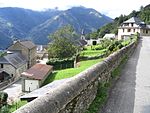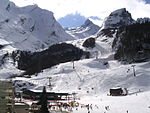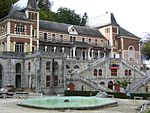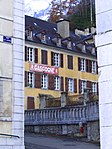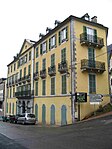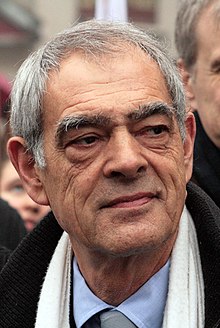Eaux-Bonnes
| Eaux-Bonnes | ||
|---|---|---|

|
|
|
| region | Nouvelle-Aquitaine | |
| Department | Pyrénées-Atlantiques | |
| Arrondissement | Oloron-Sainte-Marie | |
| Canton | Oloron-Sainte-Marie-2 | |
| Community association | Vallée d'Ossau | |
| Coordinates | 42 ° 58 ′ N , 0 ° 23 ′ W | |
| height | 520-2,619 m | |
| surface | 38.52 km 2 | |
| Residents | 243 (January 1, 2017) | |
| Population density | 6 inhabitants / km 2 | |
| Post Code | 64440 | |
| INSEE code | 64204 | |
| Website | www.gourette.com | |
 View of Eaux-Bonnes |
||
Eaux-Bonnes is a French municipality with 243 inhabitants (at January 1, 2017) in the department of Pyrénées-Atlantiques in the region Nouvelle-Aquitaine (before 2016: Aquitaine ). The municipality belongs to the Arrondissement of Oloron-Sainte-Marie and the Canton of Oloron-Sainte-Marie-2 (until 2015: Canton Laruns ).
The residents are called Eaux-Bonnais or Eaux-Bonnaises . The name in the Gascognic language is Las Aigas Bonas .
geography
Eaux-Bonnes is located about 40 km south-east of Oloron-Sainte-Marie in the Vallée d'Ossau in the historic province of Béarn on the south-eastern edge of the department on the border with the neighboring department of Hautes-Pyrénées .
The highest point in the municipality is the Géougue d'Arre ( 2619 m ).
The community consists of four districts:
- Eaux-Bonnes was founded in the 18th century because of a thermal spring . The district is slightly elevated above the Valentin River on a fall step that creates an impressive waterfall.
- Aas is the origin of the community and is located on a slope on the opposite side of the Valentin. Aas has lived from natural pasture farming since its inception and is known as the "village of the pipers" because the residents can communicate with each other over long distances by whistling .
- Assouste on the northwestern edge of the municipality is located in the Ossau valley.
- Gourette is at an altitude of over 1300 m and is a winter sports resort with one of the largest ski areas in the Pyrenees .
- Districts of the municipality of Eaux-Bonnes
The place is surrounded by the neighboring communities:
| Béost | ||
| Laruns |

|
Béost |
| Laruns | Arrens-Marsous (Hautes-Pyrénées) |
Eaux-Bonnes lies in the catchment area of the Adour River . A tributary of the Gave d'Ossau , the Valentin, flows through the municipality as well as its tributaries:
- Ruisseau de Louesque,
- Ruisseau d'Esquerra,
- Ruisseau des Blanques,
- Cély,
- Ruisseau de Portaig and
- Sourde.
history
The municipality of Eaux-Bonnes was created through the merger of the former municipalities of Aas and Assouste on May 29, 1861.
Toponyms and mentions of carrion were:
- Haas (1343, manuscript from 1343),
- Ahas-en-Ossau (1384, notaries of Navarrenx ) and
- Saint-Laurent-d'Aas (1654, incorporated into the Diocese of Oloron ).
In the 1385 census of the Béarn, 13 households were counted in Aas and it was noted that the community is in the Bailliage of Ossau.
Toponyms and mentions of Assouste were:
- Soste (1270, documents from the archdeacon of Ossau),
- Assoste and Asoste (1440, copy book ( Livre rouge ) of the Archdeaconate of Ossau) and
- Notre-Dame d'Assouste (1655, incorporated into the Diocese of Oloron ).
In the 1385 census of the Béarn eight households were counted in Assouste and it was noted that the municipality is in the Bailliage of Ossau.
Eaux-Bonnes was mentioned in 1764 in the form of Aigabonne in Laruns documents.
Toponyms and mentions of Gourette were:
- Gorrette d'Aas and Guorrette (1443, regulations of the Supreme Court of Béarn) and
- Gourrette (1675, collection of manuscripts from the 16th to 18th centuries).
Viscount Gaston Fébus von Béarn is said to have hunted Pyrenean chamois near Eaux-Bonnes in 1356 . The thermal spring of Eaux-Bonnes was first mentioned in 1462. In the 16th century, the French King Francis I had a military hospital built to treat the wounded from the Battle of Pavia (1525) . In this battle, a new type of weapon for the time, the arquebus , was used. Because of the healing properties of the thermal water, it was given the name l'eau des arquebusades . Francis I's sister, Margaret of Navarra , stayed here several times, as did Michel de Montaigne and Henry IV when they were young. The lack of adequate accommodation at that time initially slowed the further development of the health resort.
In the 18th century, the doctor Théophile de Bordeu researched the composition of water from sulfur , sulfides , chlorides , sodium , calcium and minerals and recognized the healing effects on respiratory diseases , rheumatism and osteoarthritis . Emperor Napoleon Bonaparte gave the development a boost by creating a passable road and decent accommodation. Prosper Darralde, Mayor of Navarrenx and doctor to the French Empress Eugénie , built around 15 hotels with three or four floors in Eaux-Bonnes. The Empress herself inaugurated a new approach to the springs, laid the foundation stone for the Sainte-Eugénie nursing home and saw to it that a casino was built . This development of the place attracted the aristocrats and intellectuals of the epoch. Numerous buildings in the styles of the Empire and Second Empire bear witness to the golden age of Eaux-Bonnes as a place of summer retreat and sophisticated entertainment. At the end of the 19th century, the construction of an electric tram was considered, which should allow a quick transport of guests to and from the train station in Laruns. However, the project was never implemented.
At the turn of the 20th century, winter sports emerged. Due to the luxurious and abundant accommodation capacity, several international ski competitions were initially held in Eaux-Bonnes, and from 1924 in Gourette. In 1935 it was decided to install one of the first surface lifts in France in Gourette.
The spa was closed during the Second World War . The German occupiers confiscated the hotels as accommodation for former fighters of the Spanish Civil War , Jews and various other prisoners from the nearby Camp de Gurs internment camp in preparation for another transfer to the Drancy assembly camp and from there to the extermination camp . This affected up to 458 people by December 1942. Several hundred of them boarded buses on January 18, 1943 in the square of Eaux-Bonnes, which took them to Laruns station, where a train was waiting for the prisoners. After three days and nights, the train stopped halfway to Drancy in Guéret in the Creuse department . There they were received and released by representatives of the Red Cross and mayors of the surrounding communities.
After the war, the health resort was no longer as popular as at the beginning of the 20th century. The community is currently trying to revive the spa industry with the operation of a newly built thermal bath, called “La Bulle”. In the 1960s, the first shops in Gourette opened and the ski center experienced a strong boom. Today, Gourette is a family-friendly ski resort with slopes of all levels of difficulty.
Population development
After a peak in population in the middle of the 19th century with over 900 inhabitants, it went through phases of decline and growth. Overall, the number has been reduced by more than two thirds to date and the negative trend continues.
| year | 1962 | 1968 | 1975 | 1982 | 1990 | 1999 | 2006 | 2009 | 2017 |
|---|---|---|---|---|---|---|---|---|---|
| Residents | 392 | 501 | 421 | 526 | 536 | 435 | 426 | 418 | 243 |
Attractions
- Local church dedicated to John the Baptist and Mary . During a visit by the Empress Eugénie in July 1860, she donated a generous sum for the reconstruction of the church. Gustave Lévy, architect of the department, presented his third project and work began in 1866. Construction activity ceased from 1869 to 1870 after the money ran out. It was resumed in 1875, this time according to the plans of the municipal architect Pierre Gabarret. The glass windows with figurative motifs are work of glass artist Paul Chalons from Toulouse from 1879, the stained glass windows with ornamental motifs of the glass painter Gustave Pierre DAGRANT from Bordeaux from 1881. The church was finally on May 22, 1884 consecrated . The long building contains three naves without a transept separated by arcades with lancet arches. The entrance is at the foot of the bell tower , which is flanked by two narrow towers. The solidity of the facade is supported by the regularity of the buttresses and the relatively small windows. The classical style of the church fits in harmoniously with the architecture of the surrounding buildings.
- Building in Eaux-Bonnes
Economy and Infrastructure
Services and tourism are the main economic drivers of the municipality. Eaux-Bonnes is located in the AOC zone of Ossau-Iraty , a traditionally made semi-hard cheese made from sheep's milk.

total = 201
sport and freetime
- Embedded in a park of around 100 hectares, Eaux-Bonnes offers an "adventure park" with a climbing garden and zip line.
- Eaux-Bonnes is a stage of the Tour de la Vallée d'Ossau , a circular hiking trail in seven stages with a total length of more than 100 km.
- The long-distance hiking trail GR 10 from Hendaye on the Atlantic to Banyuls-sur-Mer on the Mediterranean leads over 850 km along the Pyrenees ridge and on this way also through the municipality.
- Eaux-Bonnes offers a wide range of sporting activities in both summer and winter.
The 16th stage of the Tour de France 2007 took place on July 25th, 2007 and the 16th stage of the Tour de France 2010 took place on July 20th, 2010.
traffic
Eaux-Bonnes is connected to Routes départementales 240 and 918, the former Route nationale 618 , and is connected to other communes in the department by a line from the Transports 64 bus network from Pau to Gourette.
Personalities
- Henri Emmanuelli , born on May 31, 1945 in Eaux-Bonnes, died on March 21, 2017 in Bayonne , was a French politician , Member of the National Assembly , Secretary of State and Chairman of the Parti socialiste .
- Famous visitors to the community included a .:
- Gaston Fébus (1331-1391), Compte of Béarn
- Margaret of Navarre (1492–1549), Queen of Navarre
- Francis I (1494–1547), King of France
- Michel de Montaigne (1533–1592), lawyer, politician, philosopher and founder of essay writing
- Henry IV (1553–1610), King of France
- Théophile de Bordeu (1722–1776), doctor and founder of hydrotherapy
- Marie Thérèse Charlotte de Bourbon , known as "Madame Royale", (1778–1851), titular queen of France from 1836 to 1844
- Louis-Adolphe Thiers (1797–1877), French politician and historian
- Eugène Delacroix (1798–1863), French painter
- Friedrich Wilhelm IV. (1795–1861), later King of Prussia
- Eugène Devéria (1805–1865), French painter
- Jules Grévy (1807-1891), French President from 1879 to 1887
- Louis d'Orléans, duc de Nemours (1814–1896), second son of King Louis-Philippe I.
- Gustave Flaubert (1821-1880), French writer
- Maria Karolina Augusta of Naples and Sicily (1822–1869), member of the French royal family
- Rosa Bonheur (1822–1899), French animal painter
- Eugénie de Montijo (1826–1920), last Empress of France
- Hippolyte Taine (1828-1893), French philosopher , historian and critic
- Ismail Pasha (1830–1895), Wali (governor) and Khedive ( viceroy ) of the Ottoman province of Egypt .
- Sarah Bernhardt (1844–1923), French actress
- Philippe Pétain (1856–1951), French officer, diplomat and politician
- Louis Barthou (1862–1934), French politician
- Henri Sallenave (1881–1953), French athlete, initiator of skiing in the Pyrenees
- Cecil William Mercer (1885–1960), English writer under the pseudonym Domford Yates.
Web links
- Descriptions of the doctor Prosper de Pietra Santa about arrival, topography, climate, therapeutic benefits of the baths and tourist recommendations in the 19th century (French)
- "Transports 64" bus from the department (French)
- Eaux-Bonnes on the website of the association of municipalities (French)
- Website about the beginnings of skiing in the Pyrenees (French)
- Website of the AOP Ossau-Iraty association (French)
Individual evidence
- ↑ Pyrénées-Atlantiques Gentile ( fr ) habitant.fr. Retrieved May 6, 2017.
- ↑ Eaux-Bonnes ( fr ) Gasconha.com. Retrieved May 6, 2017.
- ↑ géoportail - Eaux-Bonnes ( fr ) Institut national de l'information géographique et forestière . Retrieved May 6, 2017.
- ↑ Ma commune: Eaux-Bonnes ( fr ) Système d'Information sur l'Eau du Bassin Adour Garonne. Retrieved May 6, 2017.
- ^ A b c d e Paul Raymond: Dictionnaire topographique du département des Basses-Pyrénées ( fr ) In: Dictionnaire topographique de la France . Imprimerie nationale. Pp. 1, 15, 57, 1863. Retrieved May 6, 2017.
- ↑ a b Prosper de Pietra Santa: Les Eaux-Bonnes ( fr , PDF) Le Livre d'histoire. May 7, 2012. Retrieved May 6, 2017.
- ↑ a b Regional Council of Aquitaine: Eaux-Bonnes ( fr ) Visites en Aquitaine. Archived from the original on September 12, 2016. Info: The archive link was inserted automatically and has not yet been checked. Please check the original and archive link according to the instructions and then remove this notice. Retrieved May 6, 2017.
- ^ Bernard M Laprade: La ligne ferroviale Buzy-Laruns ( fr ) Bernard Cauhapé. Retrieved May 6, 2017.
- ↑ a b Regional Council of Aquitaine: Station de ski de Gourette ( fr ) Visites en Aquitaine. Retrieved on May 6, 2017. ( Page no longer available , search in web archives ) Info: The link was automatically marked as defective. Please check the link according to the instructions and then remove this notice.
- ^ Christian Aguerre: Terminus clandestin dans la Creuse - 10/20/1997 ( fr ) Sud Ouest (newspaper). Retrieved May 6, 2017.
- ↑ Notre territoire ( fr ) Eaux-Bonnes tourist office. Retrieved May 6, 2017.
- ↑ Notice Communale Eaux-Bonnes ( fr ) EHESS . Retrieved May 6, 2017.
- ↑ Populations légales 2006 Commune d'Eaux-Bonnes (64204) ( fr ) INSEE . Retrieved May 6, 2017.
- ↑ Populations légales 2014 Commune d'Eaux-Bonnes (64204) ( fr ) INSEE . Retrieved May 6, 2017.
- ↑ église paroissiale Saint-Jean-Baptiste Notre-Dame-des-Infirmes ( fr ) Ministry of Culture and Communication . Retrieved May 6, 2017.
- ↑ Conseil régional d'Aquitaine: Eglise Saint-Jean-Baptiste Notre-Dame des Infirmes ( fr ) Visites en Aquitaine. Retrieved on May 6, 2017. ( Page no longer available , search in web archives ) Info: The link was automatically marked as defective. Please check the link according to the instructions and then remove this notice.
- ↑ Institut national de l'origine et de la qualité ( fr ) Institut national de l'origine et de la qualité . Retrieved May 6, 2017.
- ↑ Caractéristiques des établissements en 2014 Commune d'Eaux-Bonnes (64204) ( fr ) INSEE . Retrieved on May 6, 2017. ( Page no longer available , search in web archives ) Info: The link was automatically marked as defective. Please check the link according to the instructions and then remove this notice.
- ↑ Foret Suspendue ( fr ) loisir.fr. Retrieved May 6, 2017.
- ↑ GRP® Tour de la Vallée d'Ossau (TVO) ( fr ) Comité départemental de la Randonnée pédestre des Pyrénées-Atlantiques (CDRP 64). Retrieved May 6, 2017.
- ↑ The Pyrenees hiking trail GR 10 . Maison de la France . Retrieved May 6, 2017.
- ↑ Hiver / Été ( fr ) Eaux-Bonnes tourist office. Retrieved May 6, 2017.



